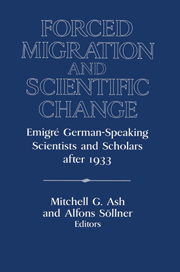Book contents
- Frontmatter
- Introduction: Forced Migration and Scientific Change after 1933
- PART ONE PHYSICAL AND MEDICAL SCIENCES
- 1 Identification of Emigration-Induced Scientific Change
- 2 Physics, Life, and Contingency: Born, Schrödinger, and Weyl in Exile
- 3 Emigration from Country and Discipline: The Journey of a German Physicist into American Photosynthesis Research
- 4 The Impact of German Medical Scientists on British Medicine: A Case Study of Oxford, 1933-45
- PART TWO PSYCHOLOGY, PSYCHONALYSIS, PEDAGOGY
- PART THREE SOCIAL SCIENCES
- Epilogue: The Refugee Scholar in America: The Case of Paul Tillich
- Index
4 - The Impact of German Medical Scientists on British Medicine: A Case Study of Oxford, 1933-45
Published online by Cambridge University Press: 05 January 2013
- Frontmatter
- Introduction: Forced Migration and Scientific Change after 1933
- PART ONE PHYSICAL AND MEDICAL SCIENCES
- 1 Identification of Emigration-Induced Scientific Change
- 2 Physics, Life, and Contingency: Born, Schrödinger, and Weyl in Exile
- 3 Emigration from Country and Discipline: The Journey of a German Physicist into American Photosynthesis Research
- 4 The Impact of German Medical Scientists on British Medicine: A Case Study of Oxford, 1933-45
- PART TWO PSYCHOLOGY, PSYCHONALYSIS, PEDAGOGY
- PART THREE SOCIAL SCIENCES
- Epilogue: The Refugee Scholar in America: The Case of Paul Tillich
- Index
Summary
Discussions of the emigration of refugee physicians and medical scientists have concentrated on a select number of outstanding researchers. Less attention has been paid to the interaction with the host academic cultures, to professional structures, and to the potential of those refused entry or career posts. Selective criteria applied at the time in the admission of emigrants have continued - with rare exceptions - to dominate the historiography of the emigration. It is all too easy to overlook the socially marginal: Certain academics came as domestic servants or gardeners, and pursued careers in fringe industrial laboratories or in general practice.
Professional factors are of special importance in the medical sphere. Restrictive professional barriers were erected for the exclusion of the rank and file of clinicians. Lord Dawson, president of the Royal College of Physicians, instructed the home secretary that “the number [of German medical scientists] who could teach us anything could be counted on the fingers of one hand.” While the Royal College of Physicians spoke for the elite of the medical profession, there was a rift between the profession and medical researchers. Long-running tensions between scientific modernizers and the traditional professional elite explain the strong medical research lobby within the Society for the Protection of Science and Learning (SPSL) who keenly sympathized with the plight of German medical researchers. A modernizing elite of physiologically trained researchers was attempting to reform the system of medical education and professional structures. Physiologists and biochemists such as Henry Dale, A.V. Hill, and Gowland Hopkins were key figures in both the Medical Research Council and the SPSL.
- Type
- Chapter
- Information
- Forced Migration and Scientific ChangeEmigré German-Speaking Scientists and Scholars after 1933, pp. 86 - 114Publisher: Cambridge University PressPrint publication year: 1996
- 5
- Cited by

